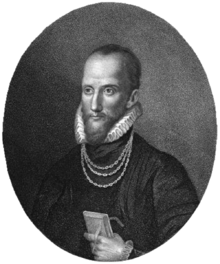Humphrey Llwyd


Humphrey Llwyd (also spelled Lhuyd) (1527–1568) was a Welsh cartographer, author, antiquary and Member of Parliament. He was a leading member of the Renaissance period in Wales along with other such men as Thomas Salisbury and William Morgan. His library, together with those of his patron, the Earl of Arundel and his brother-in-law, Lord Lumley, formed the basis of the Royal Collection of books; currently housed at the British Library. His motto was Hwy pery klod na golyd ("Fame lasts longer than wealth").[1]
Life
Llwyd was born at Foxhall, his family's estate in Denbigh, the county seat of the then county of Denbighshire. His father, Robert Llwyd, was descended from Harry Rossendale, henchman and grantee of the Earl of Lincoln.[1] The first of the family that came to Wales from England appears to have been Foulk Rosindale, from whom Foxhall, or Foulk's Hall, was called. He married into the family of the Llwyd's of Aston, the probable source where his descendants derived their name, as well as their extraction from Einion Evell of the 12th Century.[2] Einion Evell, Lord of part of Cynllaith, resided at Llwyn y Macn, in the parish of Oswestry. He and his twin brother, Cynwrig Evell, Lord of Y Glwyegl in Maelor Gymraeg, were the illegitimate sons of Madog ab Maredydd, Prince of Powys, by Eva, daughter of Madog (ab Einion Hael) ab Urien of Macn Gwynedd, ab Eginirab Lies ab Idnerth Benvras, Lord of Maesbrwg.[3]
As a young man, he was educated at Brasenose College, Oxford[1] and fared so well in the sciences and engineering that he was given a position as a physician to the Earl of Arundel during the Earl's tenure as Chancellor of the university. He was Minister to Parliament for East Grinstead during Elizabeth I's first parliament (1559).[1]
In 1563, Llwyd returned to Denbigh and lived at Denbigh Castle at the permission of Sir John Salusbury who was then the Lord of the Manor of Denbigh. That year, he was elected MP for Denbigh Boroughs during Elizabeth's second Parliament where he promoted an act allowing the translation of the Bible into Welsh.[1]
From 1566 he toured Europe, including Brussels, Augsburg, Milan, Padua and Venice. In Antwerp, he learnt from, and collaborated with, map maker Abraham Ortelius.[1] In 1567, when Llwyd returned to Denbigh, he was given a stipend from the Crown to create the first printed map of Wales.
Llwyd died in 1568 and is buried in Whitchurch, a small chapel on the outskirts of Denbigh. A Victorian-era monument honoring him still exists in St. Marcella's Church, Denbigh.
Works
No copy exists of Llwyd's translation into English of Agostino Nifo's De auguriis; Llwyd's other work includes:
- An Almanacke and Kalender, conteynynge, the daye houre, and mynute of the change of the Moone for ever, and the sygne that she is in for these thre yeares, with the natures of the sygnes and Planetes.
- Cronica Walliae a Rege Cadwalader ad annum 1294 (1559 – English adaptation of Brut y tywysogyon)
- De Mona druidum insula … epistola (1568 letter to Ortelius; published in Theatrum Orbis Terrarum)
- Commentarioli Britannicae descriptionis fragmentum (1568). Coins the term "British Empire".
- Cambriae Typus (A map of Wales published in the Additamentum to "Theatrum Orbis Terrarum")
- Angliae regni florentissimi nova descriptio (A map of England & Wales – also published in the Additamentum) [1]
Llwyd also produced two known works in the Welsh language.[1]
Footnotes
References
- BBC biography on Humphrey Llwyd
- The Cambrian Plutarch, John Humffreys Parry, London, 1824
- The history of the princes, the lords marcher, and the ancient nobility of Powys Fadog by Jacob Youde William Lloyd, London, 1887.
Further reading
- G. Penrhyn Jones (1956), Humphrey Lhuyd (1527–1568). A Sixteenth Century Welsh Physician, Proceedings of the Royal Society of Medicine, 49(8): 521–528.